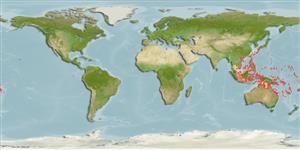Gastropoda |
Littorinimorpha |
Bursidae
Environment: milieu / climate zone / djupintervall / distribution range
Ekologi
; djupintervall 10 - 155 m (Ref. 337). Tropical
Indo-Pacific.
Length at first maturity / Size / Weight / Age
Könsmognad: Lm ? range ? - ? cm Max length : 5.5 cm ShH hane/ej könsbestämd; (Ref. 821)
Length based on occurence record; to be replaced with better reference. Maximum depth from Ref. 118675. Known from depths of 10 to 40 m, in sand pockets on reefs (Ref. 337). Dead shells rarely washed up on the beaches (Ref. 88739).
Life cycle and mating behavior
Könsmognad | Reproduktion | Lek | Eggs | Fecundity | Larvae
Members of the order Neotaenioglossa are mostly gonochoric and broadcast spawners. Life cycle: Embryos develop into planktonic trocophore larvae and later into juvenile veligers before becoming fully grown adults.
Springsteen, F.J. and F.M. Leobrera 1986 Shells of the Philippines. Carfel Seashell Museum. Metro Manila, Philippines. 377 p. (Ref. 821)
IUCN Red List Status
(Ref. 130435: Version 2025-1)
CITES status (Ref. 108899)
Not Evaluated
Not Evaluated
Threat to humans
Human uses
| FishSource |
Verktyg
Ytterligare information
Trophic EcologyFood items (preys)
Födosammansättning
Födointag
Predatorer
Population dynamicsTillväxtMax. ages / sizesLength-weight rel.Length-length rel.Length-frequenciesMass conversionAbundans PhysiologySyreförbrukning
Human RelatedStamps, coins, misc.
Internet-källor
Estimates based on models
Preferred temperature
(Ref.
115969): 23.5 - 27.9, mean 26.4 (based on 56 cells).
Fishing Vulnerability
Low vulnerability (10 of 100).
